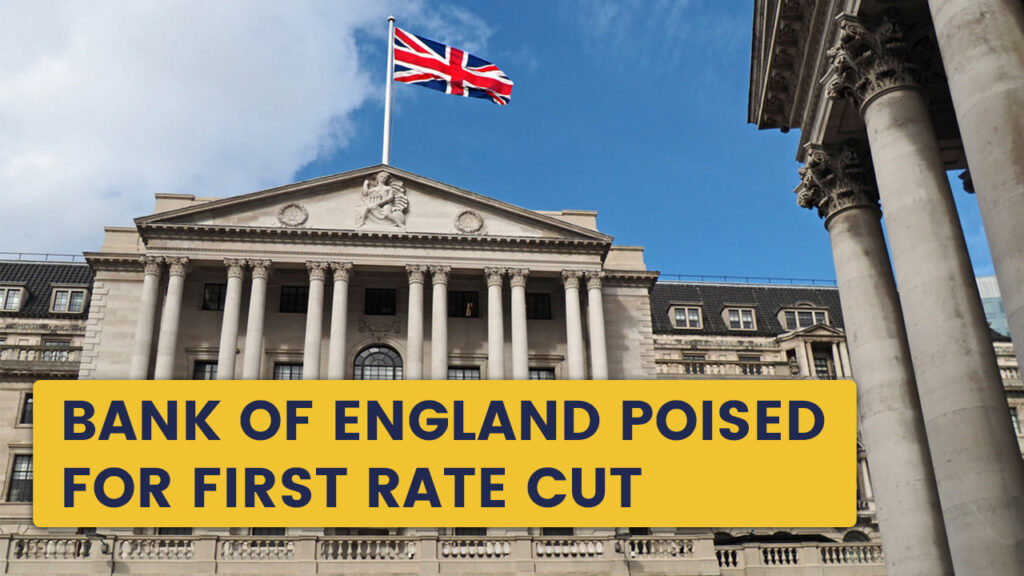Bank of England Poised for First Rate Cut: Market Implications and Sterling Outlook
Article published on February 4th, 2025 9:04AM UK Time

The Bank of England (BoE) is widely expected to cut its Bank Rate by 25bps to 4.5% in its upcoming policy decision, with markets assigning an 99% probability to such an outcome. All analysts surveyed by Reuters anticipate a measured reduction in borrowing costs, driven by slowing growth, easing inflation, and a softening labor market.
While the rate cut appears largely priced in, markets will focus on the vote split, policy guidance, and economic projections to gauge the pace of future easing. Current expectations point to a 7-2 vote split, with hawkish dissent from MPC member Catherine Mann and another policymaker likely advocating for rates to remain unchanged. The BoE is expected to maintain its cautious stance, emphasizing a “gradual approach” to rate cuts while keeping policy “restrictive for sufficiently long” to ensure inflation remains in check.
Growth Weakness and Inflation Moderation
The UK’s economic backdrop remains fragile, with consecutive GDP releases missing expectations and survey data painting a gloomy picture. The latest Composite PMI report noted that early indicators for 2025 “add to the gloom about the UK economy”, reflecting deteriorating business sentiment.
On the inflation front, price pressures have continued to ease, with headline CPI falling to 2.5% (from 2.6%) and core CPI dropping to 3.2% (from 3.5%). The key services inflation metric—closely monitored by the BoE—fell sharply to 4.4% from 5.0%, undercutting the BoE’s 4.7% forecast. In the labor market, the unemployment rate ticked up to 4.4% from 4.3%, employment growth softened, and while wage growth remained elevated, the overall labor market picture suggests waning inflationary pressures.
Despite these factors, market pricing for additional rate cuts remains cautious, with traders pricing in a second cut until May and expecting just 62bps of easing by year-end (assuming the 25bps cut on Thursday). According to Pantheon the Monetary Policy Report (MPR) is expected to raise near-term inflation forecasts while downgrading growth projections and lowering the two-year inflation outlook to 1.9% from 2.1%, reinforcing the case for gradual policy easing.
Sterling’s Resilience Amid Global Trade and Political Shifts
Despite the dovish BoE outlook, sterling has shown resilience, emerging as a safe haven among pro-cyclical currencies following the resolution of recent U.S. trade tensions. The UK’s limited exposure to U.S. tariffs—with exports to the U.S. accounting for less than 2% of GDP and to China less than 1%—has shielded the pound from trade-related volatility.
Additionally, recent diplomatic developments have lent support to sterling. U.S. President Donald Trump appears in no rush to impose tariffs on the UK, given the relatively balanced goods trade relationship. Furthermore, his recent call with UK Prime Minister Keir Starmer was reportedly amicable, reinforcing market confidence in stable UK-U.S. economic ties.
Key Risks for Sterling: Fiscal Constraints and a Dovish BoE
While GBP has held firm, risks remain. UK fiscal dynamics are under pressure, with reports expected to confirm that higher borrowing costs have eroded the UK Chancellor’s fiscal headroom. This could limit the government’s ability to support growth through fiscal policy, leaving the BoE as the primary driver of economic stimulus.
Additionally, the BoE’s tone on future rate cuts will be crucial. Should policymakers signal a more aggressive easing cycle, sterling could face renewed pressure. The BoE’s rate cut appears inevitable, but the path forward remains uncertain. Given the UK’s weaker growth outlook, policymakers will need to balance supporting economic activity with ensuring inflation remains under control.

